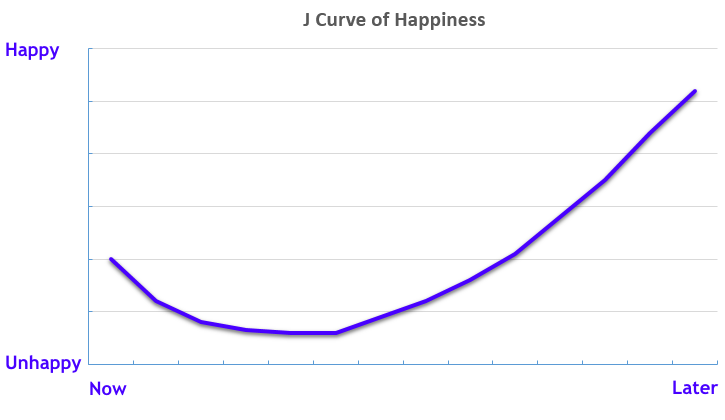Happiness and the J Curve
 “Happiness and the J Curve” became obvious to me as an article that I ought to post here after I read about the J curve in the book Thanks for the Feedback: The Science and Art of Receiving Feedback Well.
“Happiness and the J Curve” became obvious to me as an article that I ought to post here after I read about the J curve in the book Thanks for the Feedback: The Science and Art of Receiving Feedback Well.
(Aside: This excellent book teaches you as the receiver of feedback how to recognize different types of feedback and to put the power of feedback into your hands instead of into the hands of the giver.)
What is the J curve?
When it comes to the topic of happiness, it is a J-shaped curve plotted on a two-dimensional graph, with the horizontal axis representing time and the vertical axis representing happiness.
Here is how it might look:

It could be more or less pronounced than this example, but it always has the general shape of the letter J.
What does it mean?
For any given skill that you are learning, you begin somewhat happy — for at least two reasons:
- You are excited to be learning the new skill, and this excitement raises your happiness a bit.
- The initial techniques that you learn put you well ahead of complete ignorance about the skill, and this initial sense of some mastery adds to your happiness.
But, as you struggle with some concepts while you to continue to learn the new skill, your happiness plunges.
Eventually, your persistence in learning and applying the new skill pays off with higher mastery and greater happiness.
How can this help me as an endurance runner or walker?
The founder of my group training program likes to say in speeches to new marathoners:
- If you think things are going poorly during your first marathon, don’t worry. They’ll get better.
- If you think things are going well during your first marathon, don’t worry. They’ll get worse.
Veteran marathoners who hear this all laugh — because they know how true this is in a marathon.
They also laugh because they know from experience that…
[Tweet “The J curve of happiness is inevitable whenever one tries to improve during training.”]
This is true for faster sprinting, better endurance, quicker hill traversals, or anything else that comes to mind related to your endurance running or walking.
You have to be prepared for not a lot of fun in the short run before you enjoy lots of happiness in the long run.
How can I remember this at a low point?
Awareness of the J curve is necessary, but persistence in learning a new skill can be tough when you’re living in the trough of the J.
Here are three more letters that may help: V, A, and K.
- If you are a V-for-visual type, then remembering the J-curve graph may help.
- If you are an A-for-auditory type, then remembering the common “It may get worse before it gets better.” expression may help.
- If you are a K-for-kinesthetic type, then remembering the feelings of okay then bad then better during the course of a cold or flu may help.
How do YOU stick with it?
Becoming better at marathons and other endurance distances requires persistence. How do you stick with it in your own training? Share your mindset with your fellow readers by posting a comment below. Thank you!